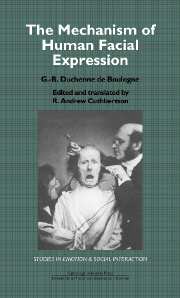Book contents
- Frontmatter
- Contents
- Acknowledgments
- Contributors
- Editor's Preface
- Part 1 The mechanism of human facial expression or an electrophysiological analysis of the expression of the emotions
- Preface
- A Introduction
- B Scientific section
- Foreword
- Chapter 5 Anatomical preparations, and portraits of the subjects who underwent electrophysiological experiments
- Chapter 6 The muscle of attention (m. frontalis)
- Chapter 7 The muscle of reflection (superior part of m. orbicularis oculi, that part of the muscle called the sphincter of the eyelids)
- Chapter 8 The muscle of aggression (m. procerus)
- Chapter 9 The muscle of pain (m. corrugator supercilii)
- Chapter 10 The muscles of joy and benevolence (m. zygomaticus major and the inferior part of m. orbicularis oculi)
- Chapter 11 The muscle of lasciviousness (transverse part of m. nasalis)
- Chapter 12 The muscle of sadness (m. depressor anguli oris)
- Chapter 13 The muscles of weeping and whimpering (m. zygomaticus minor and m. levator labii superioris)
- Chapter 14 The muscles complementary to surprise (muscles that lower the mandible)
- Chapter 15 The muscle of fright, of terror (m. platysma)
- Chapter 16 A critical study of several antiquities from the point of view of m. corrugator supercilii and m. frontalis
- C Aesthetic section
- Part 2 Commentary chapters
- Index
Chapter 7 - The muscle of reflection (superior part of m. orbicularis oculi, that part of the muscle called the sphincter of the eyelids)
Published online by Cambridge University Press: 10 November 2010
- Frontmatter
- Contents
- Acknowledgments
- Contributors
- Editor's Preface
- Part 1 The mechanism of human facial expression or an electrophysiological analysis of the expression of the emotions
- Preface
- A Introduction
- B Scientific section
- Foreword
- Chapter 5 Anatomical preparations, and portraits of the subjects who underwent electrophysiological experiments
- Chapter 6 The muscle of attention (m. frontalis)
- Chapter 7 The muscle of reflection (superior part of m. orbicularis oculi, that part of the muscle called the sphincter of the eyelids)
- Chapter 8 The muscle of aggression (m. procerus)
- Chapter 9 The muscle of pain (m. corrugator supercilii)
- Chapter 10 The muscles of joy and benevolence (m. zygomaticus major and the inferior part of m. orbicularis oculi)
- Chapter 11 The muscle of lasciviousness (transverse part of m. nasalis)
- Chapter 12 The muscle of sadness (m. depressor anguli oris)
- Chapter 13 The muscles of weeping and whimpering (m. zygomaticus minor and m. levator labii superioris)
- Chapter 14 The muscles complementary to surprise (muscles that lower the mandible)
- Chapter 15 The muscle of fright, of terror (m. platysma)
- Chapter 16 A critical study of several antiquities from the point of view of m. corrugator supercilii and m. frontalis
- C Aesthetic section
- Part 2 Commentary chapters
- Index
Summary
Plates 12, 13, 14, 15
(Alternate and compare the two sides of Plates 12 and 14 by masking the opposite side.)
Plate 12: Showing, as does Plate 13, a study of the contraction of and the expression produced by the superior part of m. orbicularis oculi (B, Figure 1), in an old man (also shown in Plates 3, 7, 8, 9).
On the right, moderate electrization of the superior part of m. orbicularis oculi: reflection.
On the left: attention.
Plate 13: Stronger electrization of the superior part of m. orbicularis oculi, with slight lowering of the labial commissures: meditation, mental concentration.
Plate 14: Designed to show a comparison between the maximal contraction of the superior part of m. orbicularis oculi and m. corrugator supercilii, in the same individual.
On the left, very strong electrization of the superior part of m. orbicularis oculi: dissatisfaction, somber thoughts.
On the right, electrization of m. corrugator supercilii.
Plate 15: To demonstrate that the mechanism of voluntary contraction of the superior part of m. orbicularis oculi is exactly the same as when it occurs under the influence of the electric current.
A strong voluntary contraction of the superior part of m. orbicularis oculi in a young subject (see his photographic portrait, Plate 4): meditation, mental concentration.
Further notes on these plates
Technical details
At the moment the photograph in Plate 12 was taken, my subject was looking opposite him, at an object on which I had strongly secured his attention; his left eyebrow was raised; his forehead was transversely creased across its whole breadth; his mm. frontalis were lightly acting and expressed the state of his spirit: attention.
- Type
- Chapter
- Information
- The Mechanism of Human Facial Expression , pp. 52 - 55Publisher: Cambridge University PressPrint publication year: 1990



